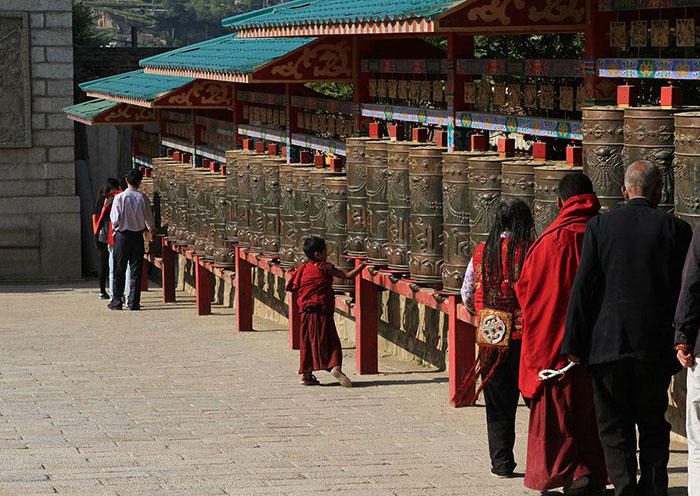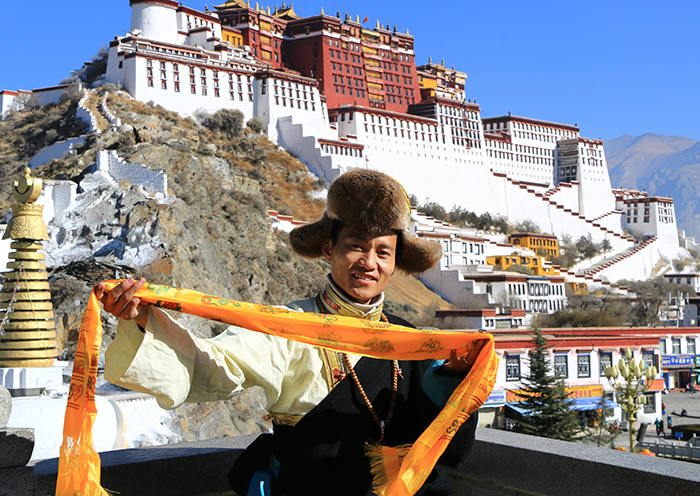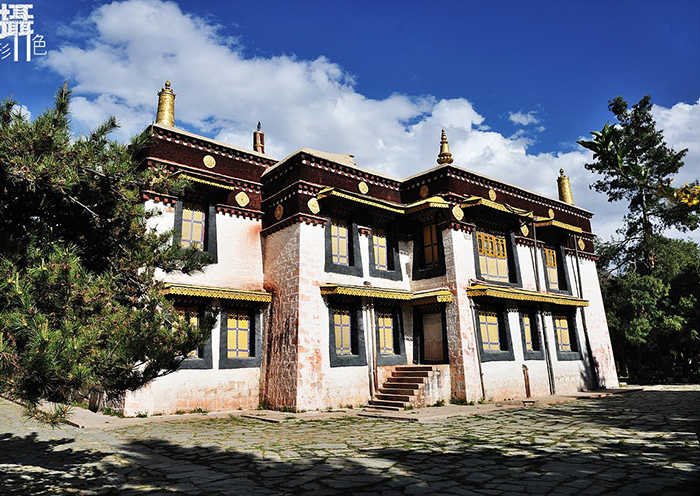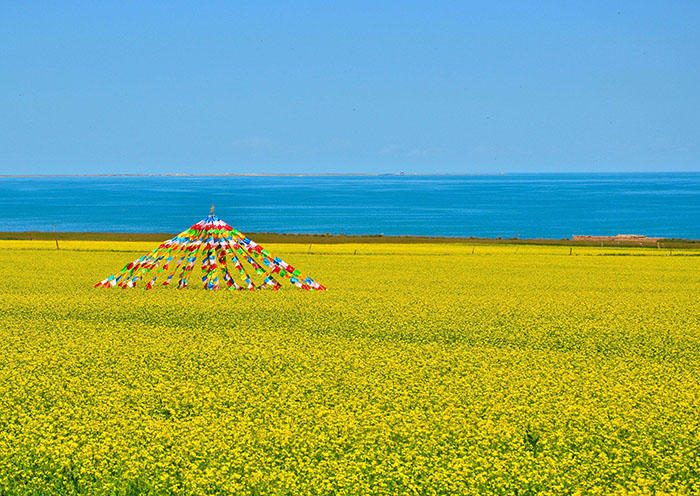Optional Activity: Authentic Sichuan Cuisine dinner at a local restaurant.
Accommodation:Overnight in Chengdu
After meeting the pandas, we’ll visit the sacred Wenshu Temple, which is hidden in a peaceful location right in the middle of modern Chengdu. This temple is the most popular Buddhist temple in the Chengdu region. With its beautiful, traditional and ancient architecture, the atmosphere is very calm and quiet, with some people praying, right in the midst of a busy and modern urban city. The grounds have a small garden and the monastery is very colorfully decorated, making it a fascinating place to visit.
After the Wenshu Temple, we will experience the leisurely pace of the life of the locals at Renmin Park and Jinlin Street. Renmin (People’s) Park is where the locals go for a relaxing walk, to meet friends or have a cup of tea. Jinli Street, by contrast, is a street mainly for tourists but it does offer a view of the way things were in ancient times. You can wander along this traditional old street to absorb the special atmosphere of Chengdu while tasting the local snacks, watching street performers, etc.
Optional Recommended Night Activity: Take in the incredible Sichuan Opera & Face Changing Performance in a local theater.
Accommodation:Overnight in Chengdu
After lunch, your tour guide will escort you to the Chengdu airport for your afternoon flight to Xining.
At the Xining airport, your local tour guide will greet you to take you by private car to your downtown Xining hotel, where you will have the rest of the evening free to relax or explore the local area on your own.
Accommodation:Overnight in Xining
We will have time for a boat cruise on the lake to visit Bird Island. On the way there, you will also visit the Riyue (Sun & Moon) Mountains, and the Ri and Yue Pagodas. These pagodas were built during the Tang Dynasty to commemorate the marriage of the Chinese Princess Wencheng to the first king of Tibet. Also nearby, you can enjoy the Daotong River, which flows from east to west, unlike nearly every other river in Qinghai.
In the evening, we will take you back to your hotel for an overnight stay in Xining.
Accommodation:Overnight in Xining
After your visit, we’ll return to Xining to catch the overnight train to Tibet, where you will be able to enjoy spectacular plateau views as you travel along the world’s highest railway on your way to Lhasa.
Accommodation:Overnight on the train
Upon your arrival at the train station in Lhasa, your local tour guide will greet you and escort you in a private vehicle and take you on to your hotel in downtwon Lhasa. Once at the hotel, you will have the rest of the day free to explore the local area around your hotel and acclimatize yourself to the air, temperature and higher altitude of Lhasa.
Tips for High Altitude Acclimatization:
1) Go for a leisurely walk in the fresh high altitude air, but avoid any strenuous activity after your arrival.
2) It's better to avoid taking a bath, to avoid catching a cold.
3) Drink plenty of water to avoid dehydration, and eat some fresh fruit.
4) Get plenty of rest.
Accommodation:Overnight in Lhasa
From one historic landmark to another, your next stop will be at the Jokhang Temple, considered as the spiritual heart of Tibetan Buddhism. Every day thousands of pilgrims come from all over Tibet and other places to the temple to worship the Buddha. The Jokhang Temple is also known as the "House of Buddha" becuase it houses the precious Jowo Rinpoche, a life-sized (1.5 meter/5 feet) image of the Shakyamuni at the age of 12.
The last stop for today's Lhasa exploration is Barkor Street, the wide, circular street that surrounds the Jokhang Temple. Local residents enjoy walking on the street, completing several circuits around the temple as a daily tradition of pilgrimage. The street also has many small shops selling a wide variety of traditional Tibetan goods, religious items and handicrafts.
Tips for today's tour:
1) There are 1,080 steps to the top of the Potala Palace, so it's best to take it slowly to avoid high altitude sickness.
2) Taking photos is not allowed inside the Potala Palace.
3) Most of today will be spent outside, so please bring a hat, sunscreen, sunglasses and some water with you to protect yourself from the more intense sun at the higher altitude.
Accommodation:Overnight in Lhasa
After visiting the palaces and park at Norbulingka, we will travel around 5 kilometers to the western outskirts of Lhasa to visit the Drepung Monastery. The word "drepung" in Tibetan language means "prosperity". Since its establishment in 1416, Drepung Monastery has served as one of the most important Buddhist monasteries in Tibet. During its prime, more than 10,000 monks lived and studied in the monastery. Throughout its history, many important and famous Tibetan leaders studied at this monastery, including the Dalai Lamas. Accordingly, Drepung Monastery is also respectfully known as the “Mother School of Dalai Lamas”.
In the afternoon, we will escort you on to another famous monastery in Lhasa - the Sera Monastery. Sera Monastery is famous for its spectacular “Buddhist Debates”. As a daily routine, the monks gather in a courtyard, and debate on the various Buddhist doctrines with exaggerated gestures, which is thought to be helpful in facilitating a better comprehension of the Buddhist philosophy to attain higher levels of study. After enjoying the "Buddhist Debates", we will take you back to your hotel with the rest of the day and evening to relax or explore on your own.
Tips for Proper Etiquette While Visiting Monasteries
1) For clothing, shorts and/or bare shoulders are not allowed.
2) Hats and sunglasses should be removed before entering the chapels.
3) Taking photos is usually not allowed inside the chapels.
Accommodation:Overnight in Lhasa
Namtso Lake is the highest altitude saltwater lake in the world at an altitude of 4718 meters above sea level. This lake is also the second largest saltwater lake in all of China, just behind Qinghai Lake in size. It’s quite common for first-time visitors to Namtso Lake to be awestruck when they first observe this fantastically beautiful lake. With snowy mountain peaks in the background and crystal-clear, dazzingly blue waters, Namtso stretches all the way out to the horizon. On clear days, the lake looks like a beautiful turquoise gem surrounded by the magnificent snow-capped Tanggula Mountains. The shores surrounding the lake are a verdant green, wide and open, dotted with the tents, yaks and sheep of the local nomads. For travelers, Namtso is an ideal place for phototography, while for Tibetans, it is a sacred and magical lake for pilgramige.
After visiting the lake, we will drive back to Lhasa to stay overnight.
Tips for today’s tour:
1) The Namtso Lake region surrounding the lake sits at an altitude of about 5,000 meters above sea level, so you should take preparations to avoid high altitude sickness. Remember to keep warm and drink plenty of water while avoiding any strenuous activities.
2) If you would prefer to spend more time at the lake and observe the sunset and sunrise over Namtso, we can stay overnight at Namtso but please keep in mind that accommodation conditions there are very basic as is the food, so it is not nearly as nice as the hotel in Lhasa.
Accommodation:Overnight in Lhasa
Today's Tips:
1) Please take care to pack all of your belongings, particularly the small things that are easy to forget about, such as phone and camera chargers, power adapters, mobile phones, wallets, etc.
2) If your flight or train is in the afternoon, please be sure to check out of your hotel room by 12 p.m.
Accommodation:None













































 Data in submission...
Data in submission...













